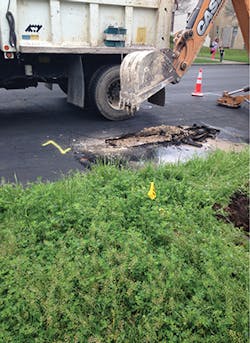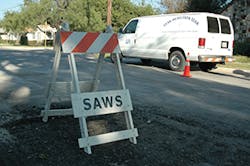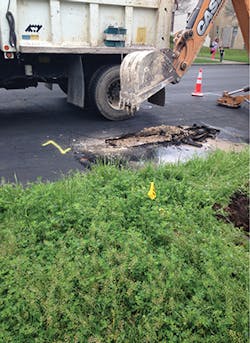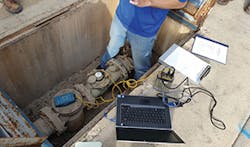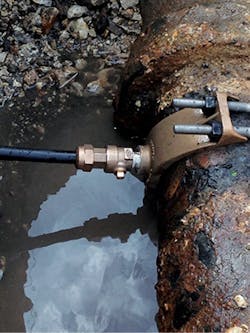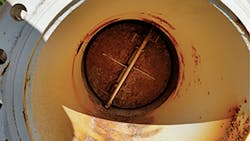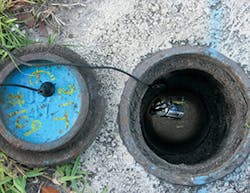How significant is the problem of non-revenue water (NRW) for water utilities? Consider this:
- The first-ever North American Water Loss (NAWL) conference, sponsored by the Georgia Association of Water Loss Professionals was held in December 2015. It attracted more than 400 participants nationwide.
- The price tag of non-revenue water is rising. US utilities are facing costs estimated at $600 billion by the US Environmental Protection Agency and up to $1 trillion by the American Water Works Association (AWWA) to upgrade aging and challenged drinking water, wastewater, and stormwater management infrastructure.
- Region-specific factors negatively impacting water utility revenues include water conservation as a result of drought, wet weather that decreases demand for irrigation, a declining customer base, slow growth in customer base and residential construction, loss of industrial and commercial demand, improved fixture and appliance efficiencies, and non-fixture conservation measures by customers, according to a 2015 Black & Veatch Water Industry Report).
Mary Ann Dickinson, president and CEO of the Alliance for Water Efficiency, notes the benefits of analyzing apparent and real losses in a utility system are “so clear as to be irrefutable.”
Miami-Dade Water and Sewer Department leak detection equipment specialist Luis Aguirre installs an alpha unit for the leak detection fixed network on an existing light pole structure.
While speaking at the NAWL conference, Dickinson asserts that water utilities resist looking for non-revenue water because of a tradition of ignoring water loss in North America. The assumption is that modern utilities are “system tight” without need for further detailed analysis. Dickinson asserts that “most utilities have largely fabricated numbers in the past on their unaccounted for water percentages.” Distribution system managers “are now embarrassed to admit that their prior numbers were actually wrong,” fearing reprisals from water utility boards.
With many utilities facing drought and asking customers to reduce water use, they are reluctant to now admit that their leakage might be excessive, Dickinson adds.
Employee performance appraisals don’t incentivize better accuracy in water loss reporting, she adds.
Also, general managers and board members assume that NRW solutions are “too costly and unaffordable, and therefore better evaluation of NRW is pointless,” says Dickinson.
Lack of dedicated utility funding for NRW is a perceived barrier to progress. “The irony is that NRW reduction actions don’t have to be funded out of stressed operating budgets where funds may be already tight,” says Dickinson. “They can be funded out of capital improvement programs or performance-based loans. The payback is excellent—money saved by recovering and selling lost water more than pays for the cost of its recovery.”
There is little perceived connection of NRW management to overall sustainability and climate change resiliency goals that the utility may have, notes Dickinson, adding that “Nothing makes a utility system more resilient than controlling its wanton leakage. Being in control of all of its assets enables a better response when water shortages occur due to climate change and other factors.”
There is little government regulation of water loss in most states, notes Dickinson. “Where state policies do exist, they are based on the antiquated ‘unaccounted for water’ percentages, which are often not accurate and can mask the true impact of leakage in different sized water systems,” she says. “Managing NRW should be a matter of government and regulatory concern. Bond rating agencies are starting to look at NRW as a way to measure utility system efficiency.”
A true business case analysis of NRW is not a prevalent practice or perceived as a necessary undertaking, Dickinson contends, adding that as such, “the benefits of reducing leakage in a utility system are not even examined. Clear payback on NRW reduction investment is not analyzed, which is an antiquated way of managing a business, let alone a precious natural resource.”
The value of water is taken for granted, both by the utility system managers and the customers they serve, says Dickinson. The “value” of water is not what the utility might have paid decades ago when it acquired the water supply—it is the marginal cost of acquiring new water, she says, adding recovering leaks then becomes the cheapest source of new supply.
When customers are willing to pay significantly more for bottled water than that from the tap, “We clearly have a problem with the customer not valuing the incredible investment in drinking water that they now enjoy for very little money,” says Dickinson. “Until we change this fundamental perception problem at both the utility and customer levels, NRW management will not reach the priority that it should.”
In many water utilities throughout the nation, NRW has indeed become a priority. Such is the case with Texas’ San Antonio Water System (SAWS), which provides service to 1.75 million customers, a number projected to double in 50 years, making the case for increased efforts in identifying NRW.
In 2003, Texas was the first state to legislate standardized auditing, says Patrick Shriver, a project coordinator in the Water Resources Department.
“We’re using the most recent guidance and tools—M36 Water Audits and Control Programs by AWWA—to do our standardized auditing,” says Shriver.
“For many years, the topic was considered water loss and people would do really simplified calculations and not go through the rigors of current auditing methodologies,” he adds. “But you’ve got to know what your numbers are before you can set goals or make improvements.”
Shriver joins other industry experts in pointing out NRW analyses are utility-specific and there is no cookie-cutter approach, as each utility’s water source is unique.
“A utility like ours relies heavily on groundwater and has more than 130 active wells in the Edwards Aquifer, and we even have other wells from other sources, so each one of those is a measuring point in Texas,” he says. “That is different than a utility that gets all of its water from one big reservoir or source.”
San Antonio Water System’s leak detection van
Validating the data is needed to determine the source of the losses, which fall into three categories, Shriver points out.
One is unbilled authorized consumption water, such as that used for flushing or firefighting.
“That’s part of the non-revenue equation,” says Shriver. “These are some of the more challenging activities to get a handle on, but they are probably the lesser amount of water.”
A second category: apparent water loss. “That’s water you deliver to a customer but for some reason is not getting billed, such as mechanical meters under-registering. The utility may have no aggressive meter maintenance program on meters that are a quite a bit old or have had a lot of consumption run through them and may not be functioning like they should,” says Shriver.
“You have to have a program that monitors and keeps that situation optimal for the utility and for the customers,” he adds. “You’ve got to be recovering your revenue. Utilities like those of our size have a very intricate billing system; you don’t want to lose any data.”
The third category: real loss—the amount of water lost in the distribution system.
“You see it on the news: a big main break and the water is shooting up like a geyser through the pavement,” says Shriver, adding these are not necessarily the leaks from which a utility loses the most water.
“A well-organized utility can respond to those and clamp them down, and what seems like forever for the people who are inconvenienced for that short period of time, that water is controlled and is managed as best as possible.”
It’s the lingering leaks that start off slow and grow throughout the distribution system that present a challenge, Shriver points out.
“Throughout North America, there are levels of ages of utilities when it comes to how they were constructed and what type of materials were used, so you’re trying to get a handle on all of those different types of leakage and address them,” he says.
Most utilities’ rates don’t produce enough revenue to repair everything at once, so they must prioritize based on the numbers and rely on proactive leak detection, Shriver points out.
Shriver says studies compiling audit data demonstrate that even though the audits are standardized, the results are different.
“They may not be doing the correct field procedures or certain things that go along with it to know what their numbers really are,” he says.
Shriver concurs with Dickinson’s assessment that a water utility’s distribution and collection department “may have been accustomed to hiding the fact their system doesn’t lose water when we know in the industry that even a new pipe has water loss,” he says.
Excavation prior to repairing leaks
SAWS has been engaged in proactive leak detection to respond to real loss—its most significant loss.
“Before our non-revenue program took off, we were scanning 20% of our systems a year, which is close to 7,000 miles of mains,” he says. “We’re doing 50% now based on recommendations of working with a loss control professional that we hired to help organize our loss control efforts. Every system is different. You have to know your economic level of leakage and know what is actually affordable to invest in based on all of the numbers.”
Lilliana Gonzalez, SAWS’ communications specialist, says that SAWS has prioritized large check valves that accounted for metered losses with 10 of its more than 130 Edwards groundwater wells.
“If these check valves fail, the meters on SAWS wells would have to pump through any raw water that would backflow into our well bores,” she says, adding that the utility has made them a prioritized maintenance item.
SAWS also mitigates apparent loss through meter profiling and rightsizing, says Gonzalez.
Close up logging equipment on large, high consumption
service
SAWS is in the early stage of identifying that some larger and high-volume customer services may be better suited to move from a mechanical meter to a full bore magnetic displacement style meter for improved accuracies, and is in the process of implementing a few, she says.
There also are ways to measure water loss against the backdrop of environmental factors such as drought.
“I like to use the Infrastructure Leakage Index [ILI],” says Shriver. “There are a lot of references to percent of total volume and it can be a little misleading. There may be utilities that are at 25% and unless you’ve combed through all of their numbers, that might be fairly acceptable.”
That’s because the region may not have a water scarcity problem, he adds.
“Whereas in Texas, the Texas Water Development Board recommends between a one and a three on the ILI because we’re south central and semi-arid, and water resources can be very strained as they were in the drought,” says Shriver.
In terms of SAWS’ NRW numbers, the water loss of about 18% is an average number for state and national comparisons, he says.
SAWS’ ILI number is between 2.2 and 2.5.
ILI is a ratio of the theoretical leakage to actual leakage from an audit, Shiver points out. “You don’t want your real leakage to be more than three times your theoretical leakage,” he adds.
SAWS also has an increased investment in point leak repair, Shriver says.
“We’re trying to improve our response times and do some more of that work on an annual basis,” he says. “When we increased our acoustic leak detection, our work orders that were generated increased by a lot—where we were handling 1,000 a year, we may be handling 2,400 in water mains, water laterals, hydrants, and valves. Leaks at the customer meter box are an even higher number. If we notice a leak on the customer’s side in terms of the service line, our conservation department works with them to get that fixed.”
Going forward, SAWS will be exploring more technology.
“We’re working our way up to using more sophisticated techniques,” says Shriver, adding the SAWS system is highly integrated. “The next thing for us is district metered areas. We’re not on AMI yet, but that
can help.”
Shriver advises other utility managers to not get overwhelmed by NRW prevention technology.
“It’s a white hot topic right now,” he says. “Do the audits and take approaches that are cost-effective and best accomplish the task for your utility and ratepayers because that’s eventually what it boils down to.”
As the largest utility in the southeastern US, Miami-Dade Water and Sewer Department operates more than 8,000 miles of water transmission and distribution lines, serving more than 2.3 million people in a 400 square-mile area.
Efforts are being made to pinpoint NRW through intelligent water loss and leak detection technologies, such as those offered by Gutermann, a Swiss manufacturer. The fixed-network leak monitoring technology is used globally in 100 cities, with Miami-Dade County being the only US utility where it is currently deployed.
Gutermann designs, manufactures, and distributes leak detection equipment, including permanent, fully automatic, correlating network monitoring systems. The company partners with technology companies such as Aclara, Veolia, Suez, Homerider Systems, IBM, and NEC.
A leaking main tap
Gutermann’s Zonescan Alpha fixed-network monitoring system uses large numbers of Zonescan sensors—also called loggers—which record and transmit vast amounts of data caused by minute vibrations and sounds from leaks in water supply pipes to a cloud-based system, which is located in Miami-Dade’s network headquarters, where monitoring is conducted.
The data is automatically analyzed, allowing for the quick and accurate identification and location of water leaks, minimizing the need to send leakage operators out to the field to verify and pinpoint the leak and reducing rates of false alarms and missed leaks.
Time and financial deficiencies are derived by not having to send crews out to do “lift-and-shift” surveys in particular reaches of the water distribution system, notes Lance Llewelyn, assistant superintendent, water transmission and distribution division for the Miami-Dade Water and Sewer Department. His staff is able to conduct correlations with the sounds given off by the permanent loggers to determine the validity of a presumed leak.
A repaired water main
“Oftentimes, we have been able to send a crew out to a specific area and within 20 to 30 meters, they are able to pinpoint the leak is there, and that eliminates them having to search the entire reach of the pipeline from one logger to the other,” adds Llewelyn.
The sensors augment an overall condition assessment program and help the county prioritize repair or rehabilitation projects.
Gutermann had approached Miami-Dade County Water and Sewer Department regarding its interest in a months-long pilot program to tweak the technology and devices to be able to have it work in concert with how the department needed it to work.
After the trial, which began in October 2014, department officials were comfortable with the technology’s capabilities. County officials wanted to procure the product, but had to do an open competitive purchase.
“We did that and Gutermann was able to show that it had the right product for the right price,” says Llewelyn, adding that the loggers were deployed in nearly 40 miles of water distribution lines in late 2015.
“When fully deployed, we have been able to achieve the industry standard goal of less than 10% non-revenue water loss, which extends the life of existing infrastructure and turns more of the water produced into revenues,” notes Uri Gutermann, chairman of Gutermann.
Miami-Dade County’s Water and Sewer Department has always had a challenge with NRW, notes Llewelyn.
“Our intent with engaging a fixed-network type of technology was to be able to make sure we could capture, in a more efficient way, the non-revenue water losses we had in the areas that were difficult for the crews to do traditional ‘lift-and-shift’, which are the downtown areas where we have constant noise,” he says.
“It’s difficult to ascertain what times of day are the quietest and in having a fixed network system in that area, we are able to have monitoring times—depending on what we realize are the quietest times of the day—to be able to listen to sounds and also in areas where we have difficulties sending folks in because of the continuously high traffic or areas of the town that are not very easy to get into because of safety reasons.”
After assessing those areas, department officials determined they’d be better served having a fixed-network type operation to monitor water loss in those areas and engaged Gutermann technology in one of those areas, says Llewelyn.
Miami-Dade Water and Sewer Department is undertaking the largest capital improvement program in the county’s history, a $13.5 billion capital improvement program to update both water and wastewater lines, as well as make upgrades to its wastewater treatment plants, of which leak detection will play a part, notes Adriana Lamar, public affairs manager for the Miami Dade Water and Sewer Department.
The county is currently working on a project in a small area of Miami where the pipes date back to the 1930s and 1940s.
“There are a lot of pipes out there that are very old and have passed a 50-year lifespan,” she says.
The underground water distribution pipe infrastructure runs the gamut of cast iron, steel, asbestos cement, PVC, galvanized iron, and concrete, says Llewelyn. Ductile iron pipe is used in replacement projects.
The Zonescan Alpha fixed network monitoring systems are being used in conjunction with several other tools, notes Llewelyn. “We still use ‘lift-and-shift’ and also have other fixed networks that we’re utilizing in areas where we find that particular application works better. The Gutermann product is one we found works better in an area where we have a lot of high rises.”
When it comes to dealing with NRW, “there is no silver bullet,” notes Llewelyn.
“The best approach is to have as many tools in your toolbox as you can to be able to use a particular application in a certain area of your distribution system,” he adds. “Some people have very heavy tree canopies that make it difficult for cellular communications, so they’ll continue to have to use a ‘lift-and-shift’ method.
“We have found in one particular area where we had to put our ‘lift-and-shift’ loggers closer together to be able to monitor sound, given the fact we have sandy soil in that area and sandy soil does mute the sound in terms of any type of leak signature that you get from the piping.”
Water utility managers need to study their systems comprehensively and approach them in a systematic way as to which technologies best serve a particular area, says Llewelyn.
“We received a proposal to review satellite imagery of leakage technology to see if something like that would suit us and we would review a proposal for a pilot at this time,” he says.
Llewelyn’s advice to other utility managers is to use as many tools as are out there, but to not get locked into any one system, “particularly because there are multiple applications for a given situation you may have.”
A springloaded check valve in a larger diameter pipe
In the District of Columbia Water and Sewer Authority, also known as DC Water, the primary focus on NRW is on technology, but more specifically on a job description: chief marketing officer.
At a recent community meeting, Alan Heymann gave a city council member his business card. “Chief marketing officer?” the council member asked. “Why does a city water utility have a chief marketing officer?”
When Heymann considers revenue resources, he looks at factors that are not traditionally considered: maximizing what the utility already has, expanding the service area, and sharing knowledge.
After a brief explanation, the council member had wondered why other water utilities didn’t have such a position.
Heymann’s job responsibilities, which began August 2015, include identifying and implementing new sources of revenue for DC Water, and working with the general manager, CEO, and other utility executives to sort through the affiliated financial, governance, and workforce challenges.
Heymann cites four reasons to do the work, adding that there is no shortage of opportunities for revenue in any of the areas.
One is an outdated revenue model. Bills have doubled in the past six years, while consumption decreases against the backdrop of rapid population growth in the District of Columbia.
Heymann notes the fastest-growing portion of an average bill is not connected to water consumption, but dedicated to paying for infrastructure upgrades to replace old pipes, correct combined-sewer overflows, or comply with regulations protecting waterways from nutrients.
DC Water’s underground infrastructure is mostly cast iron; the utility uses ductile iron when doing water main replacement.
“There may be some wood pipes in the ground in various places, but they haven’t been in operation for many years,” notes Heymann.
“We have 680,000 residents in the District of Columbia. And when you add in everybody who visits the nation’s capital or works here and commutes home at the end of the day, you’re talking about millions upon millions of people,” notes Heymann. “So we have a pretty high-profile operation here.”
At the same time, because there are a number of commuters, visitors, and a significant number of people in DC who either live in apartments or condo buildings, the Authority only has 130,000 residential customer bills that it issues monthly.
“These, along with a number of commercial accounts, pay for the work we do,” points out Heymann. “We are a non-profit public entity. Our ratepayers need a break because of the increased costs of maintaining and upgrading the system we operate and all of the environmental mandates we’re working under—especially on the wastewater side.”
Subsequently, water bills have more than doubled in the last eight years.
“In this coming fiscal year, we are looking at an average single family residential customer bill for water and sewer in the District of Columbia to be more than one hundred dollars,” notes Heymann. “Plainly, these folks need a break.”
A second factor is maximizing what the utility already has. One idea is treating sludge from neighboring jurisdictions at a lower cost than if they built their own plants.
One of the biggest projects DC Water is engaged in is on the sewer side. It’s a marketing process for biosolids.
“It’s not a new idea, but it’s still something that most wastewater utilities don’t do,” points out Heymann. “Up until recently, we have had hauling contracts and we pay good money to take biosolids off of the plant and send them out to farm fields where farmers are getting them for free. It’s such a popular program that they’re on a two-year waiting list to get it.”
Since DC Water has updated its plans to produce “this amazing, exceptional-quality, Class A biosolids product, we’ve been talking to landscapers, soil blenders, tree farmers, and gardening companies about using our stuff in their blends because plants love it, it’s great for the environment, and it’s a good example of a locally made product,” says Heymann.
Miami-Dade Water and Sewer crews work in front of the Freedom Tower in downtown Miami.
That provides the potential of saving ratepayers a significant amount of money on hauling fees and brings in revenue as well, he says, pointing out other jurisdictions have taken similar measures. Case in point: Milorganite, a biosolids fertilizer produced by the Milwaukee Metropolitan Sewerage District.
“The industry is moving from a waste disposal to a resource recovery model,” points out Heymann.
Expanding the service area is a third factor. DC Water operates Blue Plains Advanced Wastewater Treatment Plant, the world’s largest advanced wastewater treatment plant, a multi-jurisdictional facility governed by a multi-jurisdictional board.
“Our region is fragmented into two states, a handful of counties and a multitude of cities and towns along with the federal government, many of which are separately involved in various aspects of the water business,” notes Heymann, adding there are ways to collaborate for better service delivery and water security.
A fourth factor is sharing knowledge. While the revenue derived through doing so is relatively small, it helps to elevate the work of the entire industry, especially smaller utilities, where employees often juggle several responsibilities.
“There are about 53,000 water systems in the US and most of these are quite tiny, serving just a handful of people here and there,” points out Heymann. “What we don’t have in the water sector, as there has been in the energy space for 40 years now, is economies of scale.”
Each one of the small water utilities has it’s own human resources and finance departments, as well as its own procurement, meaning that each buys chemicals in very small quantities, Heymann points out.
“We see the opportunity to provide some services along the lines of what we know and what we do best to some of these smaller operations,” he says. “That could be anything from how you setup an automatic metering system or sharing the best ways to communicate with your customers about lead or combined sewer overflows—issues being faced by these different jurisdictions.”
Smaller operations may not have a full-time communications staff member, but his agency has a team, notes Heymann.
“We spend money developing materials that are industry recognized and they do the job well. The notion is that we can gang up with other larger utilities and share what they know in service to improve the industry, while raising a little bit of revenue to give our ratepayers a break. That’s what led George Hawkins, the head of DC Water, to create the position I’m in.”
Miami-Dade County Water and Sewer Department
NRW is “something we are concerned about because you want to sell what you produce and distribute,” notes Heymann. “But at the same time, we are not dealing with issues of water scarcity as they are in other parts of the country. We have something on the order of 1,300 miles of water pipes in the district and the median age is 79 years. We have water pipes that went in before the Civil War and are still operating fine, and we have pipes that are 50 years old that are breaking every day.”
While DC Water has a typical number of water main breaks in a year for a system of its size, age, and composition, the agency is always seeking new ways to predict which pipe is going to break and fix it before it does, says Heymann, adding that “Service interruptions are a headache, they’re costly, and there can be property damage.”
In the last fiscal year, DC Water, for the first time, instituted a water system replacement fee. It’s a fixed fee tied to the size of the customer’s water meter that is directly applied to the cost of replacing the water infrastructure.
“We’ve got a 1% replacement rate now and just years ago it was a third of a percent a year, which means we had a new system every 300 years which is obviously inadequate,” says Heymann. “We’re aiming for that 1% and that’s what’s going to pay for it.”
Heymann advises other water utilities contemplating establishing the role of a chief marketing officer that “if you do it right, it pays for itself many times over.”
A zonescan logger inside a valve
That means choosing someone who knows the institution, Heymann adds. He had previously worked for the water utility as the chief of external affairs and served as the architect of a 2010 utility rebranding campaign.
The job is different from a traditional marketing position in that “You’re going out there and finding new ways for the place to make money,” says Heymann. “You’re going to be engaged primarily in marketing what you do best and you have to know what that is. You have to know who your in-house experts are and also you have to know how to navigate.”
Heymann says a “fascinating part” of his job is in finding people within the administration who are willing to take risks, examine problems from different directions, and “transcend the ordinary.”
“Government water utilities are full of people like that, but you’ve got to seek them out in different pockets and figure out where they are,” he says. “Then you’ve got to demonstrate some success in showing the rest of the folks that this is worthwhile work because salaries aren’t free and you need to keep justifying your existence.”
The ROI for the position is derived when those marketing efforts start to draw more revenues, he adds.
